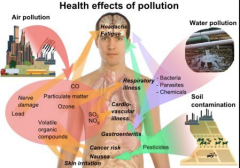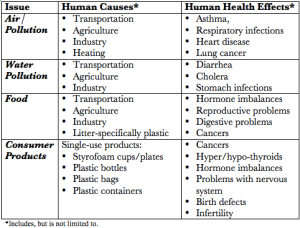Sometimes, when I say something about the environment I know to be truth, I’m faced with confusion or out-right disagreement. The most obvious of which—Global Warming isn’t the fault of humans—also being the most ridiculous. For those people who Alyssa and I haven’t yet convinced that global warming is, in fact, real and, in fact, the fault of humans I’m not sure what else to say, other than look at this website. Maybe they’ll have better luck.
For everyone else, there are still some environmental misconceptions, especially in relationship to our health.
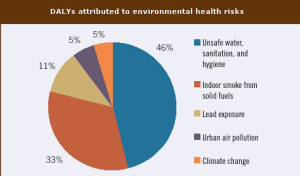
In 2013 all Earth life is faced with greater levels of toxicity than ever seen during the era of humans. Both unfortunately and ironically this happens to be the fault of humans too. The toxicity that I’m talking about manifests in a ton of different forms, in our air, soil, water, food… And all of those things may have a different effect on our health.
I wrote a blog post a couple months ago about pollution from landfills and several health problems, especially asthma. More recently I wrote a post about how cigarette butts can pose huge hazards to human and animal life. And just the other day I posted about the health effects of Styrofoam cups. Perhaps for some of you these things were already clear, but until having done the research I was completely unsure of what was true and what was not. And I think this is completely understandable because there’s a ton of literature out there on it—some reliable, some not so reliable—and most it is confusing or contradictory.
For instance, when I was reading about Styrofoam I learned that many people consider them more environmentally friendly, simply because they measure being “good” for the environment in a different way than I would. If you don’t want to take my word for it read more here.
The following is a chart of three of the various ways that toxicity in our environments affects our health.
While all of these types of pollution/environmental abuse are potentially health threatening, I want to focus on consumer products because it seems to be both the only factor we can exert personal control over.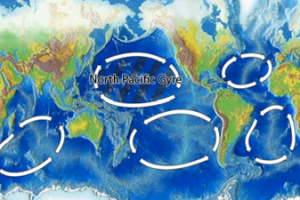
In 5 major areas of the globe’s oceans there are enormous gyres of plastics that are called Garbage Patches. Our ocean’s currents converge in these areas, bringing along with them hundreds and thousands of pounds of plastics, where they, over the course of years, break down into smaller and 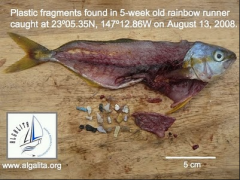 smaller pieces of plastic. Because these plastics breakdown into miniscule pieces birds and marine life often believe them to be food—plankton—and these animals ingest the plastic. Through the various levels of the food chain fish end up full of these plastics and the toxins that they leach. Often these fish end up on our tables—end up being our food—and, in turn, release toxins into our bodies.
smaller pieces of plastic. Because these plastics breakdown into miniscule pieces birds and marine life often believe them to be food—plankton—and these animals ingest the plastic. Through the various levels of the food chain fish end up full of these plastics and the toxins that they leach. Often these fish end up on our tables—end up being our food—and, in turn, release toxins into our bodies.
All of this seems a little unbelievable, but the details are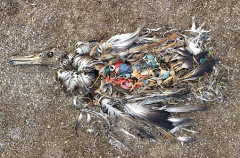 even more astonishing. Not only are at least 100,000 marine animals killed yearly via starvation (the plastics don’t digest in their bodies, so the animals feel full and stop eating), but the plastics that are filling up our oceans are estimated to weigh more than 100 million tons, creating the potential for vast numbers of other animals to be ingesting great amounts of plastic—but instead of starving to death, these fish are harvested and sold in our supermarkets. How appetizing.
even more astonishing. Not only are at least 100,000 marine animals killed yearly via starvation (the plastics don’t digest in their bodies, so the animals feel full and stop eating), but the plastics that are filling up our oceans are estimated to weigh more than 100 million tons, creating the potential for vast numbers of other animals to be ingesting great amounts of plastic—but instead of starving to death, these fish are harvested and sold in our supermarkets. How appetizing.
On land, plastics do a significant amount of damage in other ways. The buzzword here, ladies and gentlemen, is Bisphenol A (aka BPA). This chemical can be found in water bottles, baby bottles, plastic toys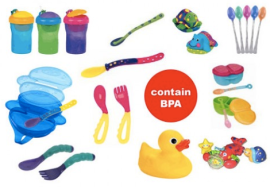 , lining the insides of metal containers, and in various other places. BPA has been linked with a wide array of serious health issues including heart disease, breast cancer, diabetes, attention deficit disorder, ovarian disease, and low sperm counts. Studies show that most any plastics (even those without BPA) have other toxins, such as Polyethylene Terephthalate (PET), that leach toxins that act like estrogen into beverages and foods.
, lining the insides of metal containers, and in various other places. BPA has been linked with a wide array of serious health issues including heart disease, breast cancer, diabetes, attention deficit disorder, ovarian disease, and low sperm counts. Studies show that most any plastics (even those without BPA) have other toxins, such as Polyethylene Terephthalate (PET), that leach toxins that act like estrogen into beverages and foods.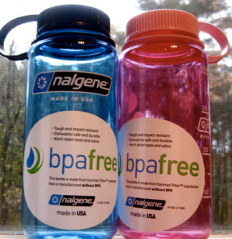
Basically, despite the wide array of research boils down to is this: synthetic products can have severely negative effects on both the environment and our health. To best protect ourselves from such dangers—environmental and otherwise—I suggest swapping out plastic products for reusable metal, glass, or even paper products. Get coffee at Bagelz? Use a travel mug! Drink from plastic water bottles? Use a metallic one! Or a plastic one that’s BPA free. Afraid of tap water? Buy a Britta filter and filter you own water!
In essence? Avoiding the problem is easy—so long as we’re aware it’s there.
-M

